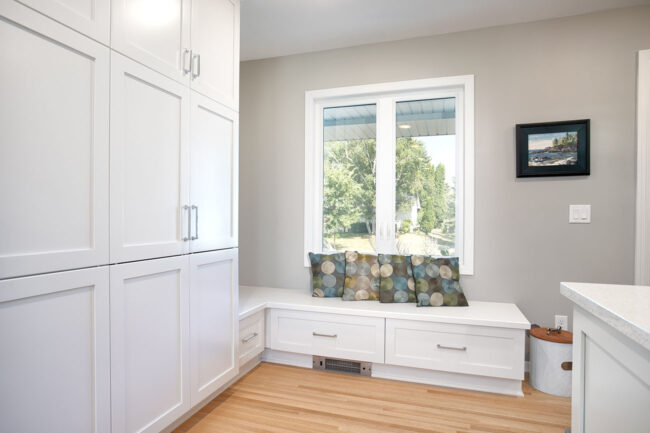14 Ways to Make Your Home More Sustainable For Earth Day

As the world approaches another Earth Day, people everywhere are looking for ways to live more sustainably. Despite recent global efforts to slow global warming, 2021 was one of the six hottest years since 1800 and greenhouse gases on the Earth’s surface are higher than ever.
Instead of relying on governments and big businesses to make changes, individuals need to change their habits and reduce their footprint, starting at home. Whether you’re building a new home or adapting a preexisting one, you’ll find something on this list to reduce your impact on the planet.
1. Install Low Flow Fixtures
Upgrading your plumbing fixtures to low-flow models can save you serious cash and drastically reduce water consumption. Swapping out your toilet alone can save the average household 13,000 gallons of water annually. Less expensive upgrades like low-flow shower heads and faucet aerators can also help you reach your goals.
2. Invest in Energy Star Appliances
Modern conveniences like refrigerators, washing machines, dishwashers and water heaters save you valuable time and improve your quality of life, but they hurt the environment. Replacing these items with Energy Star alternatives will add up to significant energy savings, making them a more sustainable choice while reducing your bills.
3. Swap Out Your Lightbulbs
It’s time to consider switching your lightbulbs to something more energy efficient. Traditional incandescent lights use up to 90% of their energy as heat, which is wasteful and potentially dangerous. On the other hand, LEDs put off very little warmth. Plus, they last around 30 times longer than your average bulb, keeping more harmful materials out of landfills.
4. Hook up a Smart Thermostat
A smart thermostat is a handy tool that can save money and help lower your negative impact on the planet. They have many helpful functions, like an app to control your heating and cooling from anywhere.
It can also learn your patterns and adjust the temperature to give you the best experience. Some even keep track of the weather and change setting accordingly. At any time, you can access your home’s energy use for heating and cooling and get recommendations for how to save money and energy moving forward.
5. Turn Off the Lights
This tip is completely free but will substantially impact your energy use. All you have to do is remember to turn off the lights whenever you leave a room. Work with your whole household to make this a habit. You can even invest in smart bulbs so you can turn them off remotely in case you forget.
6. Repair Existing Damage
When your home needs repairs, it can bleed energy, costing you money and causing a negative environmental impact. Leaky plumbing influences your water use and can cause severe damage. You should also check for higher-than-normal energy bills since these could indicate roof damage or inadequate insulation.
7. Take Shorter Showers
Another easy and free habit is to change your bathing habits. A quick shower with a low-flow shower head is more water efficient than taking a bath. Make the most of each wash-up by turning the heat down a bit and seeing how much you can shorten your time. You can also turn the water off while you lather to save more.
8. Start Composting
A staggering 28% of waste in landfills could have been composted, contributing to greenhouse gas emissions instead of helping new things grow. Starting a compost bin at your home is easy to set up and relatively inexpensive. You can save all your table scraps and put them to good use.
9. Grow Your Food
Another great way to make your home more sustainable is to grow your own food. It will take work and some startup costs, but it can save you money in the long run. You don’t have to go completely off the grid and support yourself entirely, but even small steps can reduce the carbon footprint of transporting groceries to your store and then to your house.
10. Optimize Your Windows
Older homes often contain single-pane windows, allowing your heated or cool air to escape fairly easily. Your HVAC then has to work even harder to keep your house at the right temperature. Instead of throwing money out the window and wasting energy, replace old frames with more effective double-paned models.
11. Install Solar Panels
Most energy-saving tips help you reduce your consumption, but this one will let you create your own. Installing solar panels is a costly upgrade, sitting between $15,000 and $25,000, depending on your location. However, if you live in an area with good sunlight year round, you can drastically reduce your energy bills and even sell your excess to the local utility companies.
12. Get Curtains
Improve the style of your home and reduce your energy consumption in one fell swoop by installing curtains. This tip is especially effective if your windows are a bit drafty, but you can’t afford to replace them yet. Adding curtains can reduce heat loss by one-third in these situations. You can also minimize the sun’s heating effects during warm months by closing curtains on the most affected side of your house.
13. Install a Grey Water System
Most people don’t think twice about the water that leaves their tub, dishwasher or washing machine — yet they’re the biggest water consumers in homes. Give the leftovers a second life by collecting this grey water and repurposing it around your house. Simple collection systems are suitable for watering non-edible plants. However, if you want to use the water in your garden or home, you must remove bacteria and other contaminants with a filtration system.
14. Wash With Cold Water
Did you know 90% of your washing machine’s energy comes from water heating? Reduce the load on your clothes, wallet and the environment by laundering in cold water instead. New models can clean effectively without turning up the heat. Plus, the water doesn’t get warm enough to kill germs unless you run a sanitizing cycle.
Replace Only What You Need
Looking over this long list of sustainable swaps, additions and habits can feel inspiring. You may feel tempted to dive right in and begin making these changes.
However, a word of caution — only replace what absolutely needs it. Yes, new efficient appliances can save you money in the long run and drastically reduce your energy use, but if your old one still worked fine, you’ll be adding to the waste in landfills for no reason. You can’t undo the purchases you’ve already made. Use what you have for now and make more sustainable choices moving forward.

